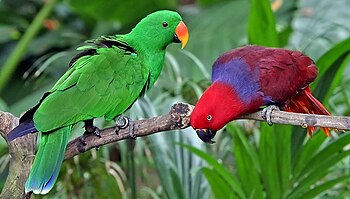 |
| Eclectus Parrot - Male (left) and Female, Singapore Zoo (Photo credit: Wikipedia) |
This extraordinary bird originates from the South Pacific. There are six subspecies of the Eclectus available in the United States presently: Red-Sided, Grand, Solomon Island, Vosmaeri, McGillvary, and Biaki. The Red-Sided, Vosmaeri and Grand subspecies are the most common.
The male Eclectus is translucent green with red under his wings and a yellow or orange beak. The Vosmaeri male also has a yellow band on his tail. The female Eclectus are usually red and mauve, but some are red with a blue-violet belly and underwings. Also, the female has a black beak.
The minimum cage size for keeping one Eclectus parrot is three feet long by two feet wide by two feet tall. This is very small for this bird though. You should try to get a much larger cage. You will have to let the bird out of the cage a lot so they get the activity they need. They need to be let out at least an hour each day.
In the wild, the Eclectus eats mostly vegetables, fruits, and legumes. They don't eat seeds, so don't get a diet with seeds. For the primary diet, get a pellet based one. They will also need to get fresh fruits and vegetables each day. This bird is deficient in many nutrients and also has a very long digestive tract. Because of this, it is imperative that they are fed a good diet. Try to limit the amount of fat they get so that they don't develop fatty tumors. This doesn't mean to take fat entirely out of the diet though, they still need some.
The Eclectus parrot has excellent talking capabilities. They love to mimic every sound they hear, even the dog, doors opening, microwaves, and sneezing! You will be amazed at how much they sound like the real sound. Your bird's speaking ability will depend on how much time you spend with the bird, how much you talk to the bird and how much of a bond the bird has with you.
This bird is also very curious and loves to explore new things. They are extremely playful and really enjoy playing with people, other birds, and toys. They are very smart birds and can even be potty trained. Another great thing about them is how tidy they are. They don't throw food everywhere like many other bird species do.
Unlike many other birds, the Eclectus doesn't produce feather dust. They have an oil gland instead of a dust gland. You won't see dust on their beaks. A healthy bird's beak will appear clean and shiny.
The female Eclectus is the dominant sex of this species. For this reason, many people notice that their female bird gets slightly aggressive when they reach puberty. Just make sure she has her space whenever she gets a mood swing. She is not being mean, it's just her hormones. Most females will calm down as they get older and as you spend more time with them.
The main thing to remember with the Eclectus parrot is that you will need to spend plenty of time with it. If you don't, they will do anything to get your attention, such as making extremely loud screaming noises. You have to be prepared for the amount of time this bird takes. Your bird could live to be fifty years old so you will have it for a very long time if you take good care of it.
|



I'm glad that you took the time to write a blog about these wonderful parrots but unfortunately much of you statements are not true. Mostly it was information about the subspecies but a little about their diet as well. The most common eclectus in the US is undoubtedly the Solomon island eclectus. Your comment is also misleading about male vos eclectus and yellow on their tail. Most males have hints of yellow or cream at the tips of their tail but the female vos is what should be mentioned with a thick yellow band on her tail. most female eclectus don't have that yellow. Now with their diet you said they don't eat seeds in the wild. This is kind of true. They don't eat the seeds you would buy at a pet store in the wild but they definitely eat seeds. they eat mostly fruit seeds. Lastly you said they should have a pellet base diet. pellets are mostly soy, corn, and wheat, all of which are not natural foods and should only be give in small amounts. Pellets also almost always have added vitamins which are vary back for eclectus as it causes tow tapping as well as other problems not to mention artificial colors are particularly bad. The right pellets in small amounts helps keep a well rounded diet for an eclectus. They should be on mostly fresh base diet with a little bit if nuts, seeds, and pellets, to make sure our bird's nutritional needs are met
ReplyDelete